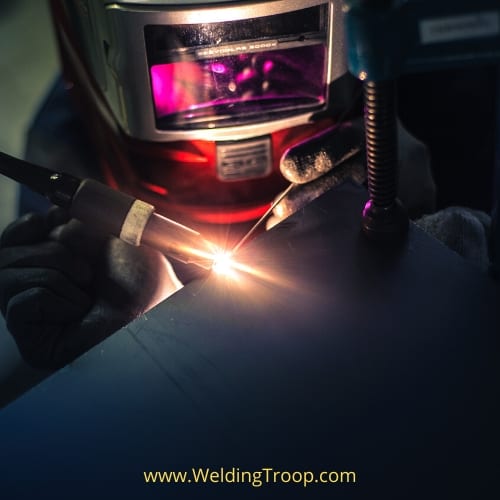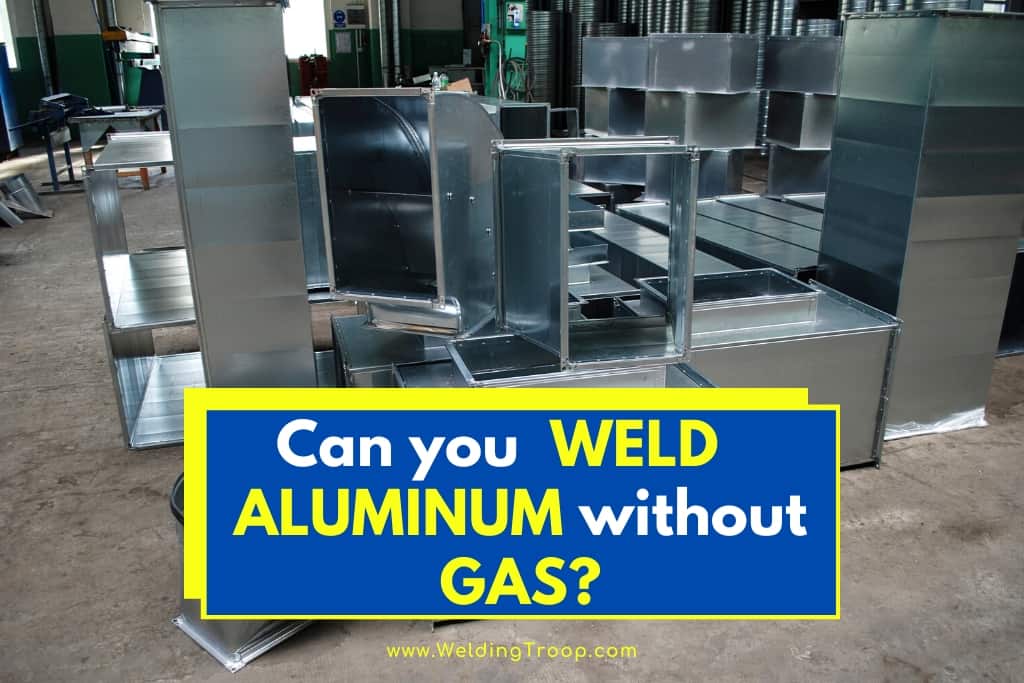MIG or TIG welding is accomplished with an inert gas to provide for an oxygen-free environment around your aluminum material, and therefore to help you accomplish a clean weld. But what if you are out of gas and only have a few more welds to make before you’re finished with your project. It can be difficult to know what supplies there are to help you and what supplies are only there to hurt your pocket.
Can you weld aluminum without gas? Yes, aluminum can be welded without gas in a vacuum chamber. However, welding aluminum gasless will expose the metal to the oxygen air circulating around your workspace and will make for a less secure weld.
Structural welding should never be done without inert gas because the connections cannot be relied on to hold properly. Cosmetic jobs can sometimes be accomplished without the use of gas, but structural jobs cannot. Welding aluminum must be done with the use of gas, especially when the project is structural in nature.
While you can’t weld structural components without the aid of an inert gas, it is technically possible to weld more cosmetic components without it. An experienced welder will be able to make the best of any situation, no matter how far it is from ideal, right? It’s conceivable that a weld could be accomplished in the open air if a great deal of weight is not involved.
Table of Contents
So, Is It Possible to Weld Aluminum Without Gas?
Before we get started with how it can be possible, some background information is required. Two of the most common types of welding are MIG and TIG, which stand for Metal Inert Gas, and Tungsten Inert Gas, respectively.
You’re either being reminded of something you already know, or you’re learning that for the first time, but there is a very simple point to be observed in either case: inert gas is an essential part of the equation.
Without gas, the weld will not hold up the way it’s supposed to. Aluminum oxides will pollute the welded connections, along with bubbles from the material’s reaction to the atmosphere. Just because it’s technically possible to weld without inert gas, it is not recommended. If gas wasn’t essential, the acronyms would be different, wouldn’t they?
When Can I Weld Without Gas?
Unfortunately, there are few projects suitable for welding without inert shielding gas. With typical welding, like MIG and TIG, the only suitable applications are projects as small as beginning welding tutorials.
Welding objects like aluminum soup cans and similar lightweight materials are fine without shielding gas because little is at stake. Any project that requires tidiness or structural integrity will not work without gas. Learning the basics of the craft, however, can be done without gas.
Before you continue reading, here is an article we wrote about aluminum welding: Can MIG Welders Weld Aluminum? | How to successfully weld Aluminum?
There are more industrial applications that we will get into further along in the article that do not require the use of inert gas in order to achieve a proper weld. But for the vast majority of applications, gas is required in order to ensure that the weld has done its job.
One of the few potential applications for gasless welding is creating designs or adding signatures to an already completed piece of work. Because gas is crucial for creating weight-bearing applications, the only applications where gasless welding can really be applied are with cosmetic projects.
If you wish to emboss a name or a design on a piece of metal, gas will not be required because no weight will be exerted on it.

What Is Shielding Gas?
Inert shielding gas is what allows for clean connections in welding. Without shielding gas, the material and the molten metal are exposed to the atmosphere and begin to deteriorate before cooling. The gas helps the seal happen before nature sets in to prematurely tear the materials apart.
There are several different types of shielding gases:
Argon
Argon is the most common type of shielding gas used, and often forms the base of many different commercially available blends. Argon is also one of the most expensive gases, which limits its use to mostly professionals and those who can buy it in a blend – typically with carbon dioxide.
Carbon Dioxide
Carbon dioxide is one of the cheapest inert gases used. Carbon dioxide is often added as a filler to more expensive gases like argon. There are negatives to carbon dioxide that are not present with argon, such as its tendency to create excess droplets with aluminum.
Helium
Helium is lighter than air and therefore requires larger flow rates in order to control it. Helium will dissipate and rise, whereas carbon dioxide will sink down. Helium is not right for every application, but because of its inert properties, it will not react chemically with materials like aluminum or steel.
Oxygen
Oxygen is very flammable but can be used in small concentrations to dilute gases like argon. Oxygen is a less common additive for welding metals like aluminum but is commonly used for materials like stainless steel.
Vacuum Chamber Welding
Vacuum chambers remove air from the equation, and therefore remove the need for gas. If you are welding aluminum in a vacuum chamber, then you do not need gas for it to work. Vacuum chambers make use of a confined space, the chamber, then removes all the air with a vacuum pump. This creates an air-free environment where shielding gases are not necessary in order to ensure a clean weld.
Aluminum can be welded without gas in a vacuum chamber, and also makes an excellent material for construction of the vacuum chamber itself. Vacuum chambers are often very expensive and not typically used in the garage, making them something of a rarity outside industrial settings.
This specialty form of welding can be used to accomplish anything from high-performance engine parts to high-pressure aluminum air ducts. It’s possible to find a vacuum chamber outside the confines of a laboratory, but it’s fairly rare. Vacuum chambers tend to be used almost exclusively in industrial and highly specialized applications but are commonly used to weld aluminum.
Friction Stir Welding
Friction stir welding is another kind of industrial specialty welding that does not require gas in order to ensure a proper connection. In fact, friction stir welding works by essentially melting the components together into one solid piece.
The welds created by the friction stir method are so perfect that they do not show up on an X-ray as multiple pieces. They are quite literally fused into one.
Parts for underwater applications or air tanks for use in outer space are often friction stir welded together. This type of welding is incredibly specialized, and therefore would never be used for home use. But aluminum can be welded with this method, and therefore without the use of gas.
Friction stir welding can be done in the home workshop, but it is considered a very specialized technique.
Welding Aluminum Without Gas
Welding aluminum without gas is possible, but not for typical applications. The most common types of welders rely upon inert gases like argon in order to ensure a proper seal. Without a gas like argon present, atmospheric gases will lead to degradation of the aluminum before it can set.
Gasless welding can be accomplished with aluminum in typical settings, but only for cosmetic purposes. Anything application with structural or weight-bearing requirements needs to be welded with gas.
Recommended Reading
Is it Safe to Weld in the Wind? Maximum Wind Velocity
How to Weld Aluminum at Home >> A Beginner’s Guide
Aluminum MIG welding WITHOUT gas >> Check out the video below

